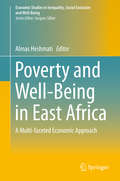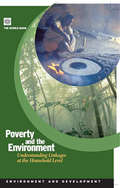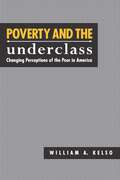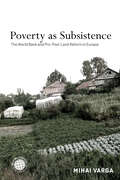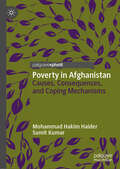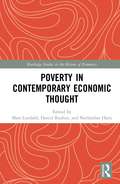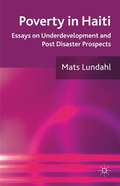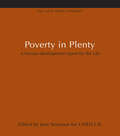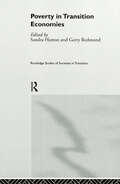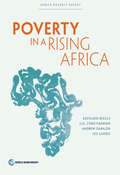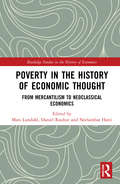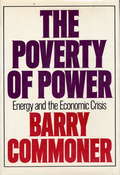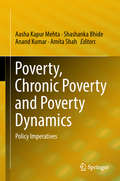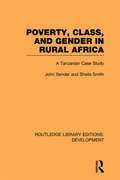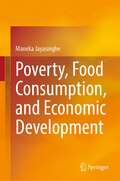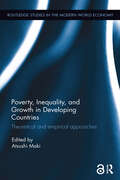- Table View
- List View
Poverty and Well-Being in East Africa
by Almas HeshmatiThis volume is a collection of selected studies on poverty and well-being in East Africa. Using a multidimensional approach, the authors hope to provide a broad view of poverty and a thorough account of the variables that contribute to it. As opposed to traditional studies of poverty, which focus mainly on material well-being, this volume includes criteria such as material standard of living, health, education, housing, personal security, access to information, freedom, participation in organization, corruption, trust, and employment. The studies highlighted in this volume are grouped into the following four research areas: child poverty and malnutrition, dynamics and determinants of poverty, multidimensional measures of poverty, and energy-environment-poverty relationships. Together, these studies provide a comprehensive picture of the state of multidimensional poverty, its measurement, causal factors, and policies and practices in Burundi, Cameron, Ethiopia, Kenya, Madagascar, Malawi, Mozambique, Nigeria, Rwanda and Tanzania. The methodology utilized in the studies is diverse as well, ranging from econometric analysis to decision theory, to neoclassical growth models. This book is geared towards students and researchers interested in economic development, welfare, and poverty in Africa as well as policy makers and members of NGOs and international aid agencies.
Poverty and the Environment: Understanding Linkages at the Household Level
by World BankDrawing upon recent analytical work prepared inside and outside the World Bank, this report identifies key lessons concerning the linkages between poverty and the environment. With a focus on the contribution of environmental resources to household welfare, the analysis increases our understanding of how specific reforms and interventions can have an impact on the health and livelihoods of poor people. 'Scholars and development practitioners increasingly recognize that in low-income countries there are inextricable links between poverty reduction and natural resources management. Demand has grown immensely for not only more, but better empirical evidence on those links. This volume offers a careful synthesis of key findings from growing literature on the environmental determinants of household welfare, as reflected by indicators of consumption, health, and income. The primary contribution of this study is that is has drawn out vital policy conclusions that will be of value to organizations and governments concerned about poverty and the environment in the developing world.' --Professor Christopher B. Barrett, Cornell University
Poverty and the Underclass: Changing Perceptions of the Poor in America
by William A KelsoExplains the failure—on both sides of the aisle—of the War on PovertyThe much-heralded War on Poverty has failed. The number of children living in poverty is steadily on the rise and an increasingly destructive underclass brutalizes urban neighborhoods. America's patience with the poor seems to have run out: even cities that have traditionally been havens for the homeless are arresting, harassing, and expelling their street people.In this timely work, William Kelso analyzes how the persistence of poverty has resulted in a reversal of liberal and conservative positions during the last thirty years. While liberals in the 1960s hoped to eliminate the causes of poverty, today they increasingly seem resigned to merely treating its effects. The original liberal objective of giving the poor a helping hand by promoting equal opportunity has given way to a new agenda of entitlements and equal results. In contrast, conservatives who once suggested that trying to eliminate poverty was futile, now seek ways to eradicate the actual causes of poverty.Poverty and the Underclass suggests that the arguments of both the left and right are misguided and offers new explanations for the persistence of poverty. Looking beyond the codewords that have come to obscure the debate—underclass, family values, the culture of poverty,—Kelso emphasizes that poverty is not a monolithic condition, but a vast and multidimensional problem.During his Presidential campaign, Bill Clinton called for an overhaul of the welfare system and spoke of a new covenant to unite both the left and right in developing a common agenda for fighting poverty. In this urgent, landmark work, William Kelso merges conservative, radical, and liberal ideals to suggest how the intractable problem of poverty may be solved at long last by implementing the principles of this new covenant.
Poverty and the WTO: Impacts of the Doha Development Agenda
by Thomas W. Hertel L. Alan WintersPoverty reduction is deemed to be a centerpiece of the Doha Development Agenda currently being negotiated under the auspices of the WTO. Yet there is considerable debate about the poverty impacts of such an agreement. Some are convinced it will increase poverty, while others are equally convinced that it will lead to poverty reduction. This book brings the best scientific methods to bear on this question, taking into account the specific characteristics embodied in the Doha Development Agenda.
Poverty as Subsistence: The World Bank and Pro-Poor Land Reform in Eurasia (Emerging Frontiers in the Global Economy)
by Mihai VargaPoverty as Subsistence explores the 'propertizing' land reform policy that the World Bank advocated throughout the transitioning countries of Eurasia, expecting poverty reduction to result from distributing property titles over agricultural land to local (rural) populations. China's early 1980s land reform offered support for this expectation, but while the spread of propertizing reform to post-communist Eurasia created numerous "subsistence" smallholders, it failed to stimulate entrepreneurship or market-based production among the rural poor. Varga argues that the World Bank advocated a simplified version of China's land reform that ignored a key element of successful reforms: the smallholders' immediate environment, the structure of actors and institutions determining whether smallholders survive and grow in their communities. With concrete insights from analysis of the land reform program throughout post-communist Eurasia and multisited fieldwork in Romania and Ukraine, this book details how and why land reform led to subsistence and the mechanisms underpinning informal commercialization.
Poverty in Afghanistan: Causes, Consequences, and Coping Mechanisms
by Sumit Kumar Mohammad Hakim HaiderThis book examines the patterns, characteristics, causes and coping mechanisms of the poor in Afghanistan applying econometric and statistical techniques. The authors address and identify the extent of poverty in Afghanistan over the years, the spatial patterns and regional imbalances of poverty in Afghanistan, the distinguishing characteristics of the poor in Afghanistan, and explore shocks faced by the poor in Afghanistan as well as subsequent coping strategies. Based on household level data collected under the ‘National Risk Vulnerability Assessment’ (NRVA) survey of 2003, 2005, 2007/08 and 2011/12 of Afghanistan, the authors identify options that may enable policy makers and other stakeholders to further enable the inclusion of the poor in development processes and to successfully cope with poverty and its adverse outcomes. This short book will be of interest to students, researchers, academicians, policymakers, international agencies and NGOs at international and national levels.
Poverty in America: A Handbook (2nd edition)
by John IcelandA broad overview of poverty in the U.S., probing the various ways that it has been measured over time and the evolution of social thinking about poverty. Updated tables and a new preface.
Poverty in America: A Handbook, with a 2012 Preface
by John IcelandPoverty may have always been with us, but it hasn't always been the same. In an in-depth look at trends, patterns, and causes of poverty in the United States, John Iceland combines the latest statistical information, historical data, and social scientific theory to provide a comprehensive picture of poverty in America--a picture that shows how poverty is measured and understood and how this has changed over time, as well as how public policies have grappled with poverty as a political issue and an economic reality. Why does poverty remain so pervasive? Is it unavoidable? Are people from particular racial or ethnic backgrounds or family types inevitably more likely to be poor? What can we expect over the next few years? What are the limits of policy? These are just a few of the questions this book addresses. In a remarkably concise, readable, and accessible format, Iceland explores what the statistics and the historical record, along with most of the major works on poverty, tell us. At the same time, he advances arguments about the relative nature and structural causes of poverty--arguments that eloquently contest conventional wisdom about the links between individual failure, family breakdown, and poverty in America. At a time when the personal, political, social, and broader economic consequences of poverty are ever clearer and more pressing, the depth and breadth of understanding offered by this handbook should make it an essential resource and reference for all scholars, politicians, policymakers, and people of conscience in America.
Poverty in Ancient Greece and Rome: Discourses and Realities (Routledge Monographs in Classical Studies)
by Filippo Carlà-Uhink, Lucia Cecchet, and Carlos MachadoThis volume presents an innovative picture of the ancient Mediterranean world. Approaching poverty as a multifaceted condition, it examines how different groups were affected by the lack of access to symbolic, cultural and social – as well as economic – capital. Collecting a wide range of studies by an international team of experts, it presents a diverse and complex analysis of life in antiquity, from the archaic to the late antique period. The sections on Greece, Rome, and Late Antiquity offer in-depth studies of ancient life, integrating analysis of socio-economic dynamics and cultural and discursive strategies that shaped this crucial element of ancient (and modern) societies. Themes like social cohesion and control, exclusion, gender, agency, and identity are explored through the combination of archaeological, epigraphic, and literary evidence, presenting a rich panorama of Greco-Roman societies and a stimulating collection of new approaches and methodologies for their understanding. The book offers a comprehensive view of the ancient world, analysing different social groups – from wealthy elites to poor peasants and the destitute – and their interactions, in contexts as diverse as Classical Athens and Sparta, imperial Rome, and the late antique towns of Egypt and North Africa. Poverty in Ancient Greece and Rome: Discourses and Realities is a valuable resource for students and scholars of ancient history, classical literature, and archaeology. In addition, topics covered in the book are of interest to social scientists, scholars of religion, and historians working on poverty and social history in other periods.
Poverty in Contemporary Economic Thought (Routledge Studies in the History of Economics)
by Mats Lundahl Neelambar Hatti Daniel RauhutPoverty in Contemporary Economic Thought aims to describe and critically examine how economic thought deals with poverty, including its causes, consequences, reduction and abolition. This edited volume traces the ideas of key writers and schools of modern economic thought across a significant period, ranging from Friedrich Hayek and Keynes to latter-day economists like Amartya Sen and Angus Deaton. The chapters relate poverty to income distribution, asserting the point that poverty is not always conceived of in absolute terms but that relative and social deprivation matters also. Furthermore, the contributors deal with both individual poverty and the poverty of nations in the context of the international economy. In providing such a thorough exploration, this book shows that the approach to poverty differs from economist to economist depending on their particular interests and the main issues related to poverty in each epoch, as well as the influence of the intellectual climate that prevailed at the time when the contribution was made. This key text is valuable reading for advanced students and researchers of the history of economic thought, economic development and the economics of poverty.
Poverty in Haiti
by Mats LundahlFollowing the 2010 earthquake catastrophe, this book examines the economic and political challenges facing Haiti. It presents an overview of the country's economic history, and seeks new prospects for economic growth and development in the future.
Poverty in Latin America: Feelings/Perceptions vs Material Conditions (Elements in Development Economics)
by Verónica Amarante Maira Colacce Federico ScaleseThis Element derives subjective poverty lines for seven Latin American countries based on a Minimum Income Question included in household expenditure surveys. It compares poverty incidence under the subjective and objective approach, finding subjective poverty is larger than objective for all countries. People identified as poor are generally poor by both measures or only subjective poor, although patterns of overlapping differ between countries. It explores the factors associated to considering oneself as poor - being subjectively poor- when the per capita household income is higher than the objective poverty line. Generally, unemployment and informality are associated with higher probability of subjective poverty. Other factors not directly involving income but reflecting high economic security also tend to reduce the probability of feeling poor. Finally, the welfare stigma effect does not seem to hold, at least in terms of subjective poverty. This title is also available as Open Access on Cambridge Core.
Poverty in Plenty: A human development report for the UK (Earthscan Library Collection: Aid And Development Set Ser.)
by Jane Seymour'Poverty in Plenty breaks new ground in two ways. It is the first national Human Development Report to focus on an industrialised country and it is the first to be produced by a non-governmental organisation� While problems of poverty and deprivation are less extreme in countries such as the UK than in some other parts of the world, the human development message is still highly relevant. There are many people who suffer through inadequate housing, insufficient means to guarantee a nutritious diet and the absence of secure, rewarding and remunerative employment' From the Foreward by Sakiko Fukuda-Parr, Human Development Report Office, United Nations Development Programme 'The economics that dominates Britain � loosely known as globilisation � is a kind of religion which dictates that the worship of money should take preference over common buman values like the sharing of wealth and the right to a decent life. This report reveals the power of traditional economics over our society, and the way in which the lives of our grandmothers and grandfathers, men and women, girls and boys have been damaged and impoverished. I highly recommend it' Ann Pettifor, Director, Jubilee 2000 UK The UK's performance on poverty and deprivation ranks 16th out of 18 industrialised countries ? People living in Glasgow Shettleston are 3.8 times more likely to die before they are 65 years old than those living in Wokingham In industrialised countries, wealth and affluence are widely perceived to be growing, although not at the same rate for everyone. But economic growth is not the same as genuine human development. Poverty in Plenty applies accepted measures of human poverty � education, health and employment � to the UK, and assesses how our food and housing policies contribute to a sustainable way of life. It draws on the work of leading research institutes and campaigning groups to determine the real state of society in the UK. Using a range of indicators to measure livelihoods and well-being, the report shows how widespread poverty is and highlights the vast geographical disparities in levels of poverty that exist within the UK. It goes on to set out what urgently needs to be done to address the sobering trends revealed and describes effective policies that will allow us to improve the current situation. The findings are of vital importance to those working on social issues in the public and voluntary sectors, and to students and general readers wanting the truth behind the public statistics. Jane Seymour is an independent researcher and writer on health and environment issues. Originally published in 2000
Poverty in Plenty: The Ethics of Income (Routledge Revivals)
by J. A. HobsonFirst published in 1931, this Routledge Revivals title reissues J.A Hobson’s analysis of financial distribution in the early years of Twentieth Century Britain. The book focuses on the moral questions that he considered to be important in regard to the economic reforms that were necessary to secure the utilisation of modern productivity for the welfare of mankind. In this work, Hobson considers the wasteful working of the economic system, with its over-production, under-consumption and unemployment and states that these errors are due to the unfair way in which income is apportioned among the nations, classes and individuals that produce it. Poverty in Plenty argues for a conscious economic government inspired by a sense of justice and humanity. It makes suggestions towards the establishment of such a government and presents business prosperity as a problem of morals.
Poverty in Transition Economies (Routledge Studies of Societies in Transition #Vol. 14)
by Sandra Hutton Gerry RedmondThis study addresses the experience of, and responses to poverty in a range of transition economies including Russia, Ukraine, Hungary, Slovenia, Uzbekistan, Romania, Albania and Macedonia. It covers topics such as the definition of poverty lines and the measurement of poverty; the role of income-in-kind in supporting families; homelessness and destitution; housing; the design, targeting and administration of welfare; and personal responses to economic transition.
Poverty in a Rising Africa
by Kathleen Beegle Luc Christiaensen Andrew Dabalen Isis GaddisPerceptions of Africa have changed dramatically. Viewed as a continent of wars, famines and entrenched poverty in the late 1990s, there is now a focus on "Africa rising ? and an "African 21st century. ? Two decades of unprecedented economic growth in Africa should have brought substantial improvements in well-being. Whether or not they did, remains unclear given the poor quality of the data, the nature of the growth process (especially the role of natural resources), conflicts that affect part of the region, and high population growth. Poverty in a Rising Africa documents the data challenges and systematically reviews the evidence on poverty from monetary and nonmonetary perspectives, as well as a focus on dimensions of inequality. Chapter 1 maps out the availability and quality of the data needed to track monetary poverty, reflects on the governance and political processes that underpin the current situation with respect to data production, and describes some approaches to addressing the data gaps. Chapter 2 evaluates the robustness of the estimates of poverty in Africa. It concludes that poverty reduction in Africa may be slightly greater than traditional estimates suggest, although even the most optimistic estimates of poverty reduction imply that more people lived in poverty in 2012 than in 1990. A broad-stroke profile of poverty and trends in poverty in the region is presented. Chapter 3 broadens the view of poverty by considering nonmonetary dimensions of well-being, such as education, health, and freedom, using Sen's (1985) capabilities and functioning approach. While progress has been made in a number of these areas, levels remain stubbornly low. Chapter 4 reviews the evidence on inequality in Africa. It looks not only at patterns of monetary inequality in Africa but also other dimensions, including inequality of opportunity, intergenerational mobility in occupation and education, and extreme wealth in Africa.
Poverty in the History of Economic Thought: From Mercantilism to Neoclassical Economics (Routledge Studies in the History of Economics)
by Mats Lundahl Neelambar Hatti Daniel RauhutPoverty in the History of Economic Thought: From Mercantilism to Neoclassical Economics aims to describe and critically examine how economic thought deals with poverty and the poor, including its causes, consequences, reduction, and abolition. This edited volume traces the economic ideas of key writers and schools of thought across a significant period, ranging from Adam Smith and Malthus through to Wicksell, Cassel, and Heckscher. The chapters relate poverty to income distribution, asserting that poverty is not always conceived of in absolute terms, and that relative and social deprivation matter also. Furthermore, the contributors deal with both individual poverty and the poverty of nations in the context of international economy. By providing such a thorough exploration, this book shows that the approach to poverty differs from economist to economist, depending on their particular interests and the main issues related to poverty in each epoch, as well as the influence of the intellectual climate that prevailed at the time when the contribution was made. This key text is valuable reading for advanced students and researchers of the history of economic thought, economic development, and the economics of poverty.
Poverty in the United States
by Ann O'Leary Paula M. FrewThis important text explores the deep relationships between poverty, health/mental health conditions, and widespread social problems as they affect the lives of low-income women. A robust source of both empirical findings and first-person descriptions by poor women of their living conditions, it exposes cyclical patterns of structural and environmental stressors contributing to impaired physical and mental health. Psychological conditions (notably depression and PTSD), substance use and abuse, domestic and gun-related violence, relationship instability, and hunger in low-income communities, especially among women of color, are discussed in detail. In terms of solutions, the book's contributors identify areas for major policy reform and make potent recommendations for community outreach, wide-scale intervention, and sustained advocacy. Among the topics covered: * The intersection of women's health and poverty. * Poverty, personal experiences of violence, and mental health. * The role of social support for women living in poverty. * The logic of exchange sex among women living in poverty. * Physical safety and neighborhood issues. * Exploring the complex intersections between housing environments and health behaviors among women living in poverty. A stark reminder that health should be considered a basic human right, Poverty in the United States: Women's Voices is a necessary reference for research professionals particularly interested in women's studies, HIV/AIDS prevention, poverty, and social policy.
Poverty of Power
by Barry Commoner"In the last ten years, the United States--the most powerful and technically advanced society in human history--has been confronted by a series of ominous, seemingly intractable crises. First there was the threat to the environmental survival; then there was the apparent shortage of energy: and now there is the unexpected decline of the economy. These are usually regarded as separate afflictions, each to be solved in its own terms: environmental degradation by pollution controls; the energy crisis by finding new sources of energy and new ways of conserving it; the economic crisis by manipulating prices, taxes, and interest rates. But each effort to solve one crisis seems to clash with the solution of the others--pollution control reduces energy supplies; energy conservation jobs. Inevitably, proponents of one solution become opponents of the others. Policy stagnates and remedial action is paralyzed, adding to the confusion and gloom that beset the country." So opens Barry Commoner's The Poverty of Power, the book in which America's great biologist and environmentalist addresses himself to the central question of our day. He concludes that "what confronts us is not a series of separate crises, but a single basic deficit--a fault that lies deep in the design of modern society. This book is an effort to unearth that fault, to trace its relation to the separate crises, and to consider what can be done to correct it at its root."
Poverty, Chronic Poverty and Poverty Dynamics: Policy Imperatives
by Anand Kumar Amita Shah Aasha Kapur Mehta Shashanka BhideThis book discusses critical policy issues that need to be addressed if India wishes to achieve the SDG 1 based elusive goal of ending poverty in the country. In its nine chapters, it takes the readers through trends and estimates of poverty in India, explains changes in the way it has been measured over time and the factors that lead to persistence of poverty, draws attention to the fact that hunger is both a cause and an effect of poverty and has gender and age dimensions too. The book revisits strategies that were successful in addressing poverty emanating from situations of conflict, presents a discussion on migration as a critical coping mechanism among poor, analyses the links between ill health and poverty as well as education and poverty to draw attention to the policy imperatives that need attention.India’s report card on poverty remains dismal even though there is recognition of the importance of reducing or eliminating or ending it at both national and global levels. Despite rapid economic growth and improvement on a range of development indicators, an unacceptably high proportion of India’s population continues to suffer poverty in multiple dimensions. SDG 1 or “ending poverty in all its forms everywhere” cannot be achieved unless policies and poverty alleviation programmes understand and address chronic poverty and its dynamics. This requires that we estimate and understand the extent of poverty, the factors that lead to people getting stuck in it and the ways this can be addressed. It also requires understanding the dynamic nature of poverty or the fact that many of those who are poor are able to move out of poverty as well as the fact that many others who are not poor become impoverished. These are the issues that are comprehensively examined and addressed in this book.In addition to students, teachers and researchers in the areas of development, economic growth, equity and welfare, the book is also of great interest to policy makers, planners and non‐government agencies who are concerned with understanding and addressing poverty-related issues in the developing countries.
Poverty, Class and Gender in Rural Africa: A Tanzanian Case Study (Routledge Library Editions: Development)
by Sheila Smith John SenderFocussing on a Fieldwork study of the West Usambaras in Tanzania, this study, first published in 1990, deals with processes of class formation and capitalist accumulation, and the dynamics of rural poverty and gender relations. Arguing that rural differentiation is systematically reinforced by the socialist state, the authors offer a critique of government intervention and discuss alternative, more effective forms of policy.
Poverty, Food Consumption, and Economic Development
by Maneka JayasingheThis book investigates the relationships between economies of scale in food consumption and a number of socio-economic and demographic characteristics of households and household behavioural choices since food is the major share of household expenditure for poor households. The characteristics considered comprise household size, location, income, and gender of the head of household while the behavioural choices considered comprise the decision to consume home-grown food and the decision to adopt domestic technology to aid food preparation and consumption. The book proposes two theoretical models to rationalize the role of the consumption of home-grown food and the adoption of domestic technology in enhancing economies of scale in food consumption. Econometric models are also used to empirically test the validity of the two theoretical models while adjusted poverty estimations are derived numerically using the estimated equivalence scales. Although data used in applying these techniques are based on four Household Income and Expenditure Surveys conducted by the Department of Census and Statistics (DCS) in Sri Lanka, the methodology can be used for similar analysis in relation to any other country.
Poverty, Income and Social Protection: International Policy Perspectives
by James Midgley Richard HoeferThis book provides insights into the way social protection policy is being redefined as a result of the new commitment by governments around the world to use these programs to reduce poverty. The case studies presented show how innovations in social protection have emerged in different countries. They also discuss various aspects of social protection that will be of interest to readers. While some of the case studies are primarily descriptive and seek to document recent trends in different countries, they also address important social policy issues. Others are particularly topical because they provide useful updates on recent social protection innovations. Countries discussed include Brazil, Britain, Chile, China, Indonesia, South Africa, and the United States. This book was originally published as a special issue of the Journal of Policy Practice.
Poverty, Inequality and Growth in Developing Countries: Theoretical and empirical approaches (Routledge Studies in the Modern World Economy)
by Atsushi MakiThere are many problems regarding poverty, inequality and growth in developing countries in Asia and Africa. Policy makers at the national level and at international institutions such as the United Nations, World Bank, International Monetary Fund and others have implemented various policies in order to decrease poverty and inequality. This book provides empirical observations on Asian countries and Africa. Each chapter provides theoretical and empirical analysis on regional case studies with an emphasis on policy implications. The book will be of use to many who wish to assess and improve policies in developing countries and mitigate poverty and inequality, and stimulate growth, by drawing on relevant empirical research and economic theories. Clearly, there have been numerous policy failures and the book aims to provide a basis for improving policies and outcomes based on relevant empirical observations.
Poverty, Inequality, and Evaluation
by Ray C. Rist Frederic P. Martin Ana Marãa FernandezThe basic premise of this book is that the conversation on the future of development needs to shift from a focus on poverty to that of inequality. The poverty emphasis is in an intellectual and political cul de sac. It does not address the fundamental question of why people are poor nor what can be done structurally and institutionally to reduce and eliminate it. The various chapters illustrate in the context of various countries and sectors around the world, the significant contributions that evaluators can make in terms of improvement of the analytical framework, analysis of the performance and results of specific programs and projects, as well as assessing and designing better public management systems in terms of poverty and inequality reduction. Beyond the specific contributions presented, three characteristics characterize those evaluations to be relevant for poverty and inequality analysis: a global-local approach: Global to move beyond disciplinary boundaries and consider cross-cutting issues, local to account for the diversity of countries, sectors, institutions and cultures considered; a problem-solving orientation: The issue evaluated is the core focus and determines the choice of evaluation methods to analyze this issue from a variety of angles; an evolutionary approach: Chapters presented are from iconoclasts who do not have any pre-established theory or school of thought to defend. This is the result of openness of mind and ability to adapt the analytical framework, the evaluation methods, and the interpretation of results in a constant interaction with the stakeholders. Such characteristics make evaluation a domain that can help understand better complex issues like poverty, inequality, vulnerability, and their interactions as well as propose a relevant and useful theory of change for public policies and projects to improve the plight of a large part of the world population in industrialized and developing countries alike.
